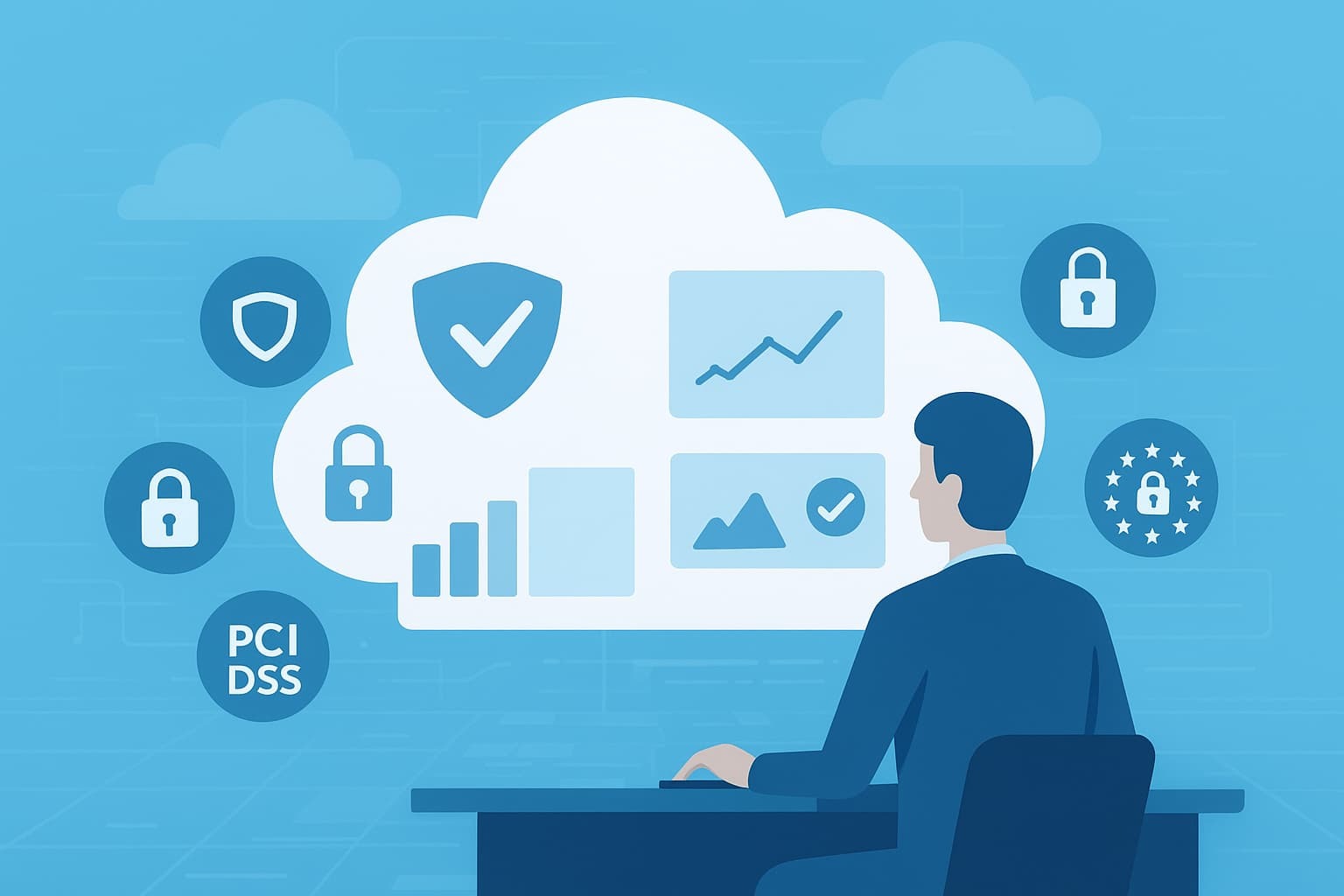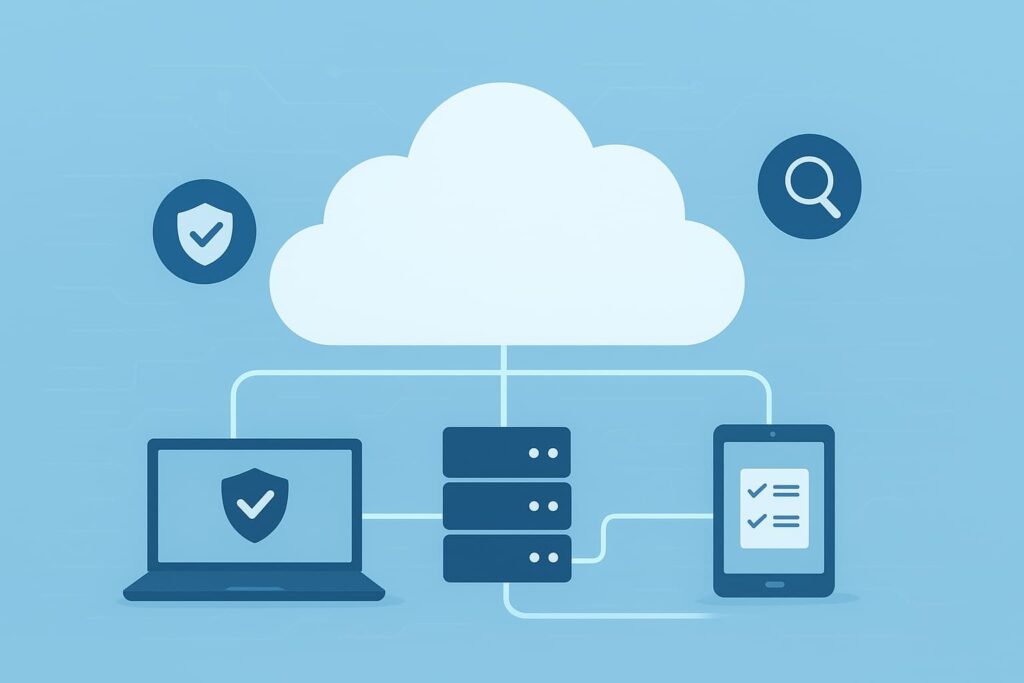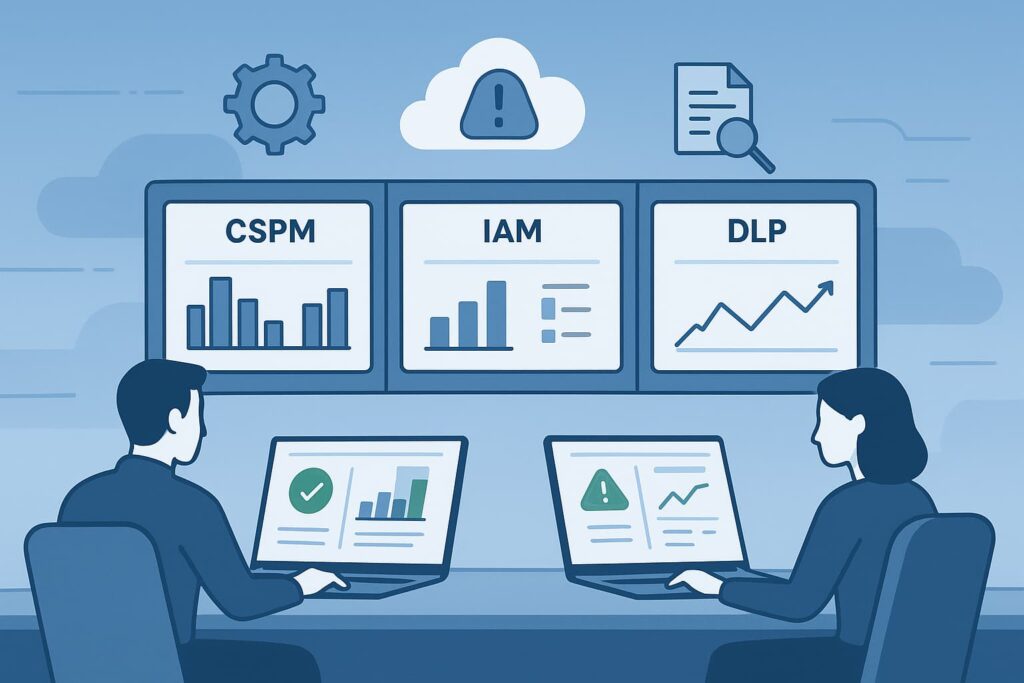Address
304 North Cardinal St.
Dorchester Center, MA 02124
Work Hours
Monday to Friday: 7AM - 7PM
Weekend: 10AM - 5PM
Address
304 North Cardinal St.
Dorchester Center, MA 02124
Work Hours
Monday to Friday: 7AM - 7PM
Weekend: 10AM - 5PM

Think of cloud security monitoring as having a guard dog for your digital warehouse. Someone’s gotta watch those server logs, track employee logins, and spot weird activity before it gets messy.
One missed setting or forgotten permission could leave the door wide open to trouble, and nobody wants to explain to the boss why they’re facing GDPR fines or HIPAA violations.
Stick around to see how real companies keep their cloud systems locked down tight.

Most security professionals think cloud compliance monitoring just means endless checklists and audits. Truth is, it’s a non-stop job of watching over cloud systems to catch problems before they blow up.
Our team spends hours combing through system logs, access records, and network data across different cloud setups, a foundation that aligns closely with the essentials of cloud security monitoring. The whole point? Spotting those configuration mistakes and odd behaviors that could spell trouble.
Working with dozens of MSSPs over the years, we’ve learned compliance isn’t just about making auditors happy, it’s about building security that actually works. These providers juggle complex client environments across AWS, Azure, and Google Cloud.
A misconfigured S3 bucket here, an overlooked permission there, small oversights quickly cascade into major headaches. That’s why continuous monitoring beats the old “check once and forget” approach. Security teams need real-time visibility to adapt to new threats and stay ahead of changing regulations.
We’ve seen too many MSSPs struggle with scattered monitoring tools that miss critical alerts. Here’s what works: pulling every scrap of data, system logs, network traffic, config changes, user logins, into one place. Sure, it’s a lot to handle, but you can’t protect what you can’t see.
Our testing shows this approach works whether providers run client systems on AWS, Azure, or split across multiple clouds.
Raw data’s useless without smart analysis. The best tools we’ve tested use advanced pattern matching to sort the real threats from everyday noise. They flag the stuff that matters, like someone accessing sensitive data at 3 AM or sudden changes in network traffic patterns.
This saves security teams from drowning in false alarms while catching the sneaky stuff that manual reviews often miss.
Nobody likes those 2 AM wake-up calls, but we’ve seen disasters avoided because someone caught an alert fast.
Through trial and error with different MSSPs, we found the sweet spot: pushing critical alerts to security teams through their preferred channels, Slack, email, or custom dashboards. No point having fancy detection if warnings sit unread in some forgotten inbox.
Running compliance checks used to mean quarterly scrambles before audits. Now we help MSSPs catch problems daily. Picture this: while one client’s team sleeps, automated tools scan their systems against HIPAA, PCI DSS, and other frameworks. No waiting for the yearly panic when auditors show up.
Finding issues is half the battle, fixing them fast is what counts. Our partners can’t afford to let vulnerabilities sit open. Sometimes it’s tweaking a permission setting, other times it’s quarantining a sketchy system. Smart automation handles the simple stuff, letting teams focus on trickier problems that need human judgment.
Clear reporting saves MSSPs from those painful “what went wrong?” conversations with clients. Through years of testing tools, we’ve found the ones that turn complex data into reports that make sense to both tech teams and executives.
These insights help spot patterns, like which security controls keep failing – so providers can fix root causes, not just symptoms.
Credit: Centraleyes – Next Generation GRC
Complying with cloud security standards means understanding the regulatory landscape and aligning your monitoring efforts accordingly. Here are some key frameworks and laws organizations must consider:
Understanding these standards is essential. We recognize that compliance is not a one-size-fits-all proposition, each organization must tailor its monitoring strategy to its regulatory obligations and operational realities. [1]
A critical concept in cloud compliance monitoring is the shared responsibility model. Cloud service providers (CSPs) secure the cloud infrastructure, physical hardware, network controls, and data centers. However, customers are responsible for securing their data, applications, user access, and configurations within the cloud.
Misunderstanding this division frequently leads to compliance gaps. We always emphasize clarifying these roles and ensuring your monitoring covers what you control to avoid costly oversights.
Start by identifying where your cloud environment might fail compliance. Assess risks linked to configurations, access controls, data storage, and third-party integrations. Prioritize these risks based on their potential business impact.
Create clear guidelines outlining compliance expectations, security controls, and responsibilities. Communicate this policy organization-wide to ensure everyone understands their role.
Regularly educate your teams on compliance requirements and best practices. Awareness reduces human errors like misconfigurations or lax access controls that could lead to breaches.
Deploy technology-enabled solutions such as Security Information and Event Management (SIEM) platforms for continuous monitoring. Complement automated tools with manual audits and penetration testing for thorough coverage.
Set up procedures for rapid remediation of non-compliance issues. Document corrective actions carefully to demonstrate compliance during audits.
Keep policies and monitoring aligned with changing regulations and business needs. Compliance is a moving target, and staying current is vital.
We’ve encountered challenges organizations face when implementing compliance monitoring:
Using a combination of these tools, integrated and managed well, forms the backbone of a strong compliance monitoring system.

At MSSP Security, we understand the complexities of cloud security compliance monitoring. Our approach also mirrors the efficiency of a managed cloud security monitoring framework, combining automation with real-time oversight to keep every environment protected.
We work alongside you to design and implement continuous monitoring strategies that reduce risk, ensure regulatory adherence, and strengthen your overall security posture.
Our approach blends automation with expert oversight, ensuring you get timely alerts, actionable insights, and swift remediation, without overwhelming your internal teams.
We’ve helped organizations navigate multi-cloud environments, manage evolving compliance requirements, and implement best-in-class security controls. Let us help you gain peace of mind knowing your cloud environments are secure and compliant. [2]
Cloud security posture management helps organizations track configurations, detect risks, and maintain continuous compliance monitoring. It works with CSPM tools to scan for misconfigurations, automate policy enforcement, and align with frameworks like PCI DSS compliance, HIPAA compliance, and GDPR compliance.
This process ensures consistent visibility and reduces security gaps across multi-cloud environments.
CWPP solutions focus on protecting workloads, like virtual machines and containers, from threats across different clouds. Cloud workload protection tools use cloud vulnerability scanning, cloud risk assessment, and anomaly detection to identify weak spots.
Together, these solutions help manage cloud workload compliance and support automated cloud security across hybrid and multi-cloud systems.
Cloud governance sets the rules and controls for how data, access, and assets are managed. It supports cloud security governance by defining cloud security policies, enforcing cloud configuration management, and maintaining accountability.
Combined with Identity and Access Management and DLP tools, strong governance ensures proper cloud access monitoring and secure cloud data protection.
Cloud SIEM integration collects and correlates cloud security logging data for real-time security alerts. When combined with cloud SOAR capabilities, it automates response workflows for cloud incident management and remediation.
This pairing strengthens security incident response, supports cloud audit trails, and helps meet compliance standards through detailed cloud security reporting and documentation.
Cloud security compliance monitoring is no longer optional, it’s an ongoing process that safeguards data, meets regulations, and builds trust. Through real-time analysis, automated threat detection, and alignment with compliance frameworks, organizations can minimize risks and ensure business continuity.
A comprehensive approach that blends advanced tools, solid governance, and expert guidance is key to success.
Partner with MSSP Security to enhance your cloud compliance strategy with proven consulting, streamlined operations, and smarter security management, ensuring your organization stays secure, efficient, and fully compliant.